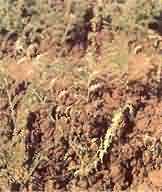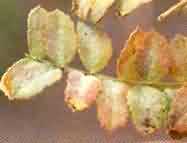चनेे की फसल के 6 प्रमुख रोग और उसका प्रबंधन
Gram commonly known as 'chick pea' or Bengal gram is the most important pulse crop in India. Chick pea occupies about 38 per cent of area under pulses and contributes about 50 per cent of the total pulse production of India. It is used for human consumption as well as for feeding to animals. It is eaten both whole fried or boiled and salted or more generally in the form of split pulse which is cooked and eaten. Both husks and bits of the 'dal' are valuable cattle feed. Fresh green leaves are used as vegetable (sag). Straw of chick pea is an excellent fodder for cattle. The grains are also used as vegetable (chhole). Chick pea flour (besan) is used in the preparation of various types of sweets. Chick pea is considered to have medicinal effects and it is used for blood purification. Chick pea contains 21.1 per cent protein, 61.5 per cent carbohydrates, 4.5 per cent fat. It is rich in calcium, iron and niacin.
ORIGIN AND HISTORY
Chick pea has been known in this country for a long time. It is said to be one of the oldest pulses known and cultivated from ancient times both in Asia and in Europe. Its probable place of origin lies in south western Asia.
The important gram growing countries are India, Pakistan, Ethiopia, Burma and Turkey. India ranks first in the world in respect of production as well as acreage followed by Pakistan.
The major chick pea production areas are situated in Madhya Pradesh, Rajasthan, Uttar Pradesh, Haryana, Maharashtra and Punjab. The main objective of this article is to provide essential knowledge to farmer about chick pea diseases and its management to ensure good yield of pulse crop in India.
|
S.N |
Diseases |
Causal Organism |
|
1 |
Wilt |
Fusarium oxysporum f.Sp. ciceri |
|
2 |
Stem Rot |
Sclerotinia sclerotiorum |
|
3 |
Botrytis Grey mold |
Botrytis cineria |
|
4 |
Ascochyta Blight |
Ascochyta rabiei |
|
5 |
Rust |
Uromyces cicer arietini |
|
6 |
Powdery mildew: |
Oidiopsis taurica |
The important diseases of chick pea are wilt, sclerotinia blight, grey mold, rust and Ascochyta blight. Symptoms of these diseases and their suitable control measures are given below:
1. Wilt of Chickpea
The main cause of this disease is a fungus, Fusarium oxysporum f.Sp. ciceri through other fungi are also associated with this disease. This disease causes considerable loss in most of the gram growing regions. The symptoms of the disease may be seen in the seedling stage as well as in an advanced stage of plant growth. The leaves start yellowing and afterwards drying. The plants too become yellowish and finally dry out. Roots turn black and ultimately decompose.

Control measures of Wilt of Chickpea
- Seed Treatment with carbendazim at the rate of 2.5 gram per Kg. of seed.
OR
Carboxin + Thiram 1:2 at the rate of 3 gram per Kg. Seed.
- Grow the resistant varieties like C-214, Avrodhi, Uday, BG-244; Pusa-362, JG-315, Phule G-5 etc.
- In fields having heavy incidence of gram wilt, the cultivation of chick pea should be avoided for three to four years.
- As far as possible sowing of chick pea should not be done before third week of October.
- Deep planting of chick pea about 8-10 centimeters deep in the light soils reduces the gram wilt incidence.
2. Sclerotinia Blight of Chickpea
It is caused by a fungus Sclerotiniasclerotiorum. The disease affects all the plants except the roots. The infection in the initial stage is visible on the stem near the ground. The affected plants first become yellow, then brown and ultimately dry out. On close observation, brown colored spots may be seen on affected stem which later girdle it. White cottony growth of the fungus with hard, black colored sclerotia may be seen on these spots on the stem.
Control measures for Sclerotinia Blight of Chickpea
- Use only healthy seeds free from sclerotia.
- Grow disease resistant varieties like G-543, Gaurav, Pusa-261 etc.
- After harvest, the diseased plants should not be allowed to stand in the field but should be destroyed by burning.
- Treat the soil with a mixture of fungicides like Brassicol and Captan at the rate of 10 kg per hectare.
- Deep summer ploughing.
3. Botrytis Grey Mold of Chickpea
This disease is caused by a fungus Botrytis cineria survives in the soil. This disease causes considerable damage in tarai area of Uttar Pradesh. Brown necrotic spots appear on twigs, petioles, leaves and flowers of the plant on attaining full vegetative growth. The branches and the stem also get affected parts. The affected stem finally breaks and the plant dies.

CONTROL MEASURES
- Plant the crop late i.e. first fortnight of November.
- Spray the crop with 0.2% carbendazim (Bavistin).
4. Rust of Chickpea
This disease is caused by a fungus Uromyces cicer arietini. The symptoms are visible in early February. Small, round to oval, light or dark brown pustules are formed on the under surface of the leaves. The pustules later turn black. Afterwards, these pustules appear on upper surface of leaves, petioles, twigs and pods. The affected leaves prematurely fall and therefore the yield is considerably reduced.
Control measures for Rust in Chickpea
- With the appearance of first symptoms, spray the crop with 0.2% Mancozeb 75 WP followed by two more sprays at 10 days interval.
- Plant only resistant varieties like Gaurav.
5. Ascochyta Blight Diseases of Chickpea
This disease is caused by Ascochyta rabiei, a fungus which survives on plant trash left in the soil. All the plant part except the root is affected. Small round, yellowish-brown spots are seen on the leaves in the months of January and February. The spots also spread to petioles and branches where they are elongated and become dark brown in color. The affected plants finally dry up.
Control measures for Ascochyta Blight disease of chickpea
- Plant only healthy seed. Before planting treat the seed with fungicides like Thiram or Carbendazim (Bavistin) at the rate of 2.5 g/kg of seed.
- Follow three year crop rotation.
- Plant resistant varieties/ tolerant varieties like G-543, Pusa-256, Gaurav, GNG-146, PBG-1 etc.
6. Powdery mildew (Oidiopsis taurica) disease of Chickpea
- Crop plants of all the age group are affected.
- With the onset of the disease white powdery mass appear on the leaves.
- Small patches of white powder coating initially develop on both surfaces of older leaves.
- Affected leaves turn purple and then die.
- When infection is severe, stems, young leaves, and pods are also covered with the powdery coating

Control measures for Powdery Mildew in Chickpea
- Field and crop sanitation.
- Dithane M-45 or Carbendazim at 2.5 g/lit should be sprayed.
Rashmi Gauraha
R.A.E.O.
Deputy Director Agriculture
E-mail:-
